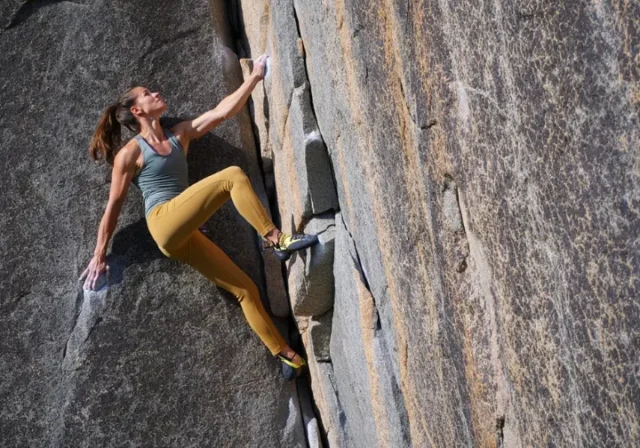In this article
Finding the perfect pair of women’s rock climbing pants can feel like its own boulder problem. You need something that moves with you, withstands scrapes against coarse rock, and stays comfortable under a harness for hours. Forget those stiff jeans or restrictive hiking pants; dedicated climbing pants are engineered for the vertical world.
This guide will serve as your route map, exploring the essential features like stretch and harness compatibility, decoding the fabric types that balance durability and breathability, tackling the common fit challenges many women face, and highlighting some top picks for various climbing styles. Let’s gear up and find the pants that will help you send your next project in comfort and style.
Key Features Explained
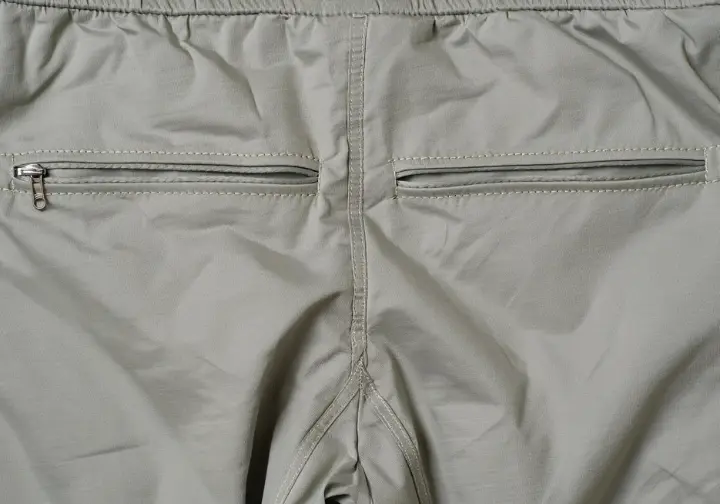
Choosing the right women’s rock climbing pants means looking beyond aesthetics to the technical details designed for performance on the wall. From the freedom needed for a high step to how seamlessly they work with climbing harnesses, these features are the foundation of a great pair of pants.
Stretch and Mobility Essentials
Unrestricted movement is crucial in climbing. We’ve all been there – a high foot placement feels impossible, not because of strength, but because our clothing is holding us back. Climbing pants use fabrics with significant stretch, often four-way stretch, allowing you to move freely without fabric binding hindering performance. Think about reaching for that distant hold or executing a wide stem; your pants shouldn’t be the crux.
A key design element enabling this freedom is the gusseted crotch. This diamond-shaped panel replaces standard seams where legs meet, dramatically increasing mobility for those high steps and wide stances common in rock climbing. It also prevents seam strain and boosts durability by distributing stress. Many climbers overlook this, opting for standard pants, only to find seams ripping during demanding moves – a common pitfall easily avoided by choosing specific pants with a gusset.
Articulated knees are another vital feature. Pre-shaped knee areas prevent fabric from bunching up behind your knees during high steps or when mantling onto a ledge. This ensures smoother, less restricted movement. The fabric weight also plays a role; lighter fabrics often feel less restrictive but might sacrifice some durability – a trade-off to consider based on your primary climbing style, whether it’s gritty granite crack climbing or smooth indoor climbing walls.
The overall fit style—slim, standard, or relaxed—also influences mobility. Slim fits minimize snagging but rely heavily on high stretch, while relaxed fits offer roominess but can feel bulky. Equally important is stretch recovery; fabric needs to bounce back after stretching. Poor recovery leads to baggy knees or seats over time, affecting both fit and function. Have you ever had pants lose their shape after just a few wears?
Harness Compatibility Secrets
For anyone climbing on a rope, harness compatibility is non-negotiable. Climbing pants designed for sport climbing or traditional climbing feature low-profile waistbands that sit flat under a harness waist belt. Look for wide, flat elastic waistbands, integrated webbing belts, or internal drawstrings. These designs minimize bulk and prevent painful pressure points, especially during long belays or unexpected falls.
Standard pants with bulky button flies, rivets, or thick belt loops are a recipe for discomfort under a harness. We’ve seen climbers tough it out, only to end the day with chafed hips. Climbing-specific designs prioritize smooth closures and waist constructions for seamless integration. Remember that time you couldn’t quite reach your chalk bag because your waistband was bunching uncomfortably? That’s what these designs prevent.
Pocket placement is also strategic. Zippered thigh pockets placed below the harness leg loops are invaluable for carrying essentials like a phone, snack, or route topo, keeping them accessible even when fully geared up. The rise of the pants (low, mid, high) also matters. Mid-rise and high-cut waist styles often work best, ensuring the harness belt sits securely over the fabric, reducing the chance of the waistband slipping or rubbing directly against your skin. Secure closures, like drawstrings or integrated belts, help keep everything in place during dynamic moves.
Functional Leg and Ankle Design
Precise footwork is fundamental to climbing, and your pants shouldn’t obscure your view of tiny footholds. Features at the ankles allow climbers to manage pant length effectively. Options include cinch cords, roll-up snaps, or elasticated cuffs (jogger style). These adjustments improve visibility of your climbing shoes and prevent tripping or fabric catching on rock features.
The jogger style, with its elastic cuffs, has gained immense popularity for both function and aesthetics. It automatically keeps ankles clear without fuss, reduces snagging, and often looks great for casual wear too. Beyond footwork, cinchable or elasticated ankles help keep dirt, pebbles, and ticks out during approaches or descents through brushy terrain – a simple feature that adds significant comfort on the journey to and from the crag.
While ankle adjustments are common, the overall leg cut matters too. Tapered legs naturally minimize excess fabric around the ankles, offering a streamlined fit. Straight leg styles provide a more traditional look but might rely more heavily on roll-up features. For rugged climbing like alpine climbing or sharp granite cracks, some technical pants feature reinforced scuff guards at the cuff to enhance longevity where abrasion is common.
Materials and Durability Focus
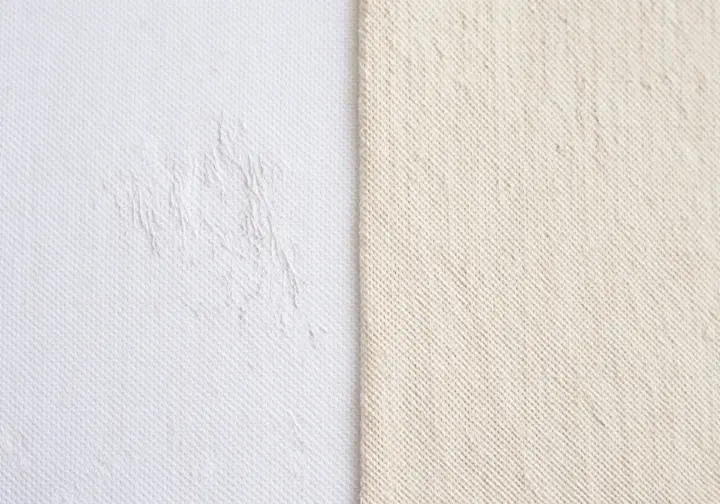
The heart of any great pair of climbing pants lies in its material. The chosen fabric dictates how well the pants withstand abrasion against rough rock, how comfortable they remain during long climbing days, and their suitability for different climates and types of climbing, from bouldering in the gym to mountaineering in the mountains.
Decoding Fabric Types
Most performance climbing pants utilize Nylon/Spandex blends. Nylon provides excellent abrasion resistance and durability, crucial for resisting scrapes on granite or sandstone. Spandex (or elastane) adds the vital stretch (typically 3-15%) needed for full mobility. This combination is a versatile workhorse suitable for everything from sport climbing to traditional climbing.
Cotton blends, often using organic cotton, are prized for softness and comfort, making them popular for indoor climbing and bouldering. They are blended with Spandex for stretch, but cotton absorbs moisture and dries slowly. This can be a drawback in cool or damp conditions, leaving you feeling chilled. Many climbers prefer synthetics for outdoor use for this reason.
Polyester blends offer good durability and dry very quickly, often faster than nylon, making them suitable for variable weather or high-sweat activities. Recycled polyester is increasingly common, offering a more sustainable synthetic option. Some find polyester retains odors more than nylon, which is a personal consideration. How important is quick-drying fabric for your typical climbing environment?
Hemp blends are gaining traction as a durable, breathable, and naturally antimicrobial fiber with good sustainability credentials. Patagonia, for example, utilizes hemp in some of their rock pant designs, often blended with recycled polyester or organic cotton to enhance softness and stretch. Ripstop weaves, incorporating reinforced threads in a grid, significantly increase tear resistance without adding much weight, preventing small snags from becoming major rips. Many pants also feature a DWR (Durable Water Repellent) finish to shed light rain, with PFC-free options being better for the environment, a focus for brands like Black Diamond.
Built to Last Construction
Climbing is tough on clothing. To combat abrasion from constant contact with rock, many climbing pants feature reinforced high-wear areas, particularly the knees and seat. These panels often use a heavier or more durable fabric to extend the lifespan, especially beneficial for techniques like kneebarring or chimneying. Quality stitching, like flatlock seams that minimize chafing and bar tacks at stress points, is also essential for longevity.
There’s often a trade-off between fabric weight and durability. Heavier fabrics generally offer greater abrasion resistance but can compromise breathability and comfort, especially in warm weather. Lightweight fabrics enhance comfort and agility but may be more susceptible to damage. Many climbers find themselves needing several pants for different conditions or climbing styles – perhaps a lighter pair for the climbing gym and a burlier pair for rugged outdoor climbs.
Long-term wear is the true test of durability. While initial reviews are helpful, seeking feedback on how specific models hold up over years of use, perhaps through online forums, can reveal potential issues like pilling or seam failures. Manufacturers constantly strive to balance toughness and breathability, using innovative weaves and blends to offer good abrasion resistance without sacrificing airflow – a crucial factor for comfort during strenuous activity.
Finding Your Perfect Fit
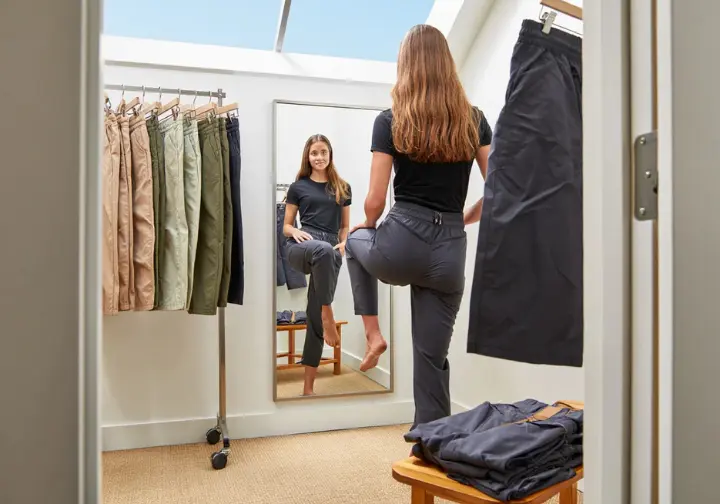
Fit can be the most challenging piece of the puzzle when selecting women’s climbing pants. An ill-fitting pair, no matter how technically advanced, can hinder movement and cause discomfort. Understanding common fit issues and terminology specific to women is key to navigating the options successfully.
Solving Common Fit Challenges
One of the most frequent complaints is the dreaded waist gap, especially for women with wider hips or thighs relative to their waist. This results in pants fitting the lower body but gaping at the back. Look for highly adjustable waistbands (like integrated belts or effective drawstrings) or specific “curvy fit” designs engineered to address this ratio. Trying on pants and mimicking climbing movements like high steps can reveal potential gapping.
Conversely, some find pants fit their waist but are too tight through the thighs and seat, restricting mobility. Prioritizing fabrics with very high stretch (10%+) and considering standard or relaxed fit styles can help. Remember that friend who couldn’t high-step because her pants were too restrictive? That’s a situation easily avoided with the right fit and fabric.
The waist rise (low, mid, high) significantly impacts comfort, especially under a harness. Mid-rise and high-rise options generally provide better coverage, prevent pants from slipping down, and ensure the harness belt rests comfortably over the pant fabric. Correct inseam length is also vital; petite, regular, and tall options prevent tripping or excessive riding up. Always check size charts and user reviews for feedback on actual length. Sizing varies wildly between brands, so consulting charts and reading fit comments from others with similar body types is crucial.
Understanding Fit Styles
Slim fit pants offer a close-to-body cut, minimizing excess fabric that could snag. They rely heavily on high stretch for mobility and provide a sleek look preferred by some for technical precision. Think performance-oriented sport climbing or bouldering.
Standard/Regular fit aims for a middle ground, providing enough room for comfortable movement without being overly baggy. It strikes a balance suitable for a wide range of climbers and activities, from everyday climbing at the local climbing gym to multi-pitch adventures. These are often great multi-purpose pants.
Relaxed fit prioritizes comfort and airflow, being looser through the hips and legs. While offering maximum roominess, be mindful that excess fabric could potentially interfere with intricate footwork or snag more easily on rock features.
The Jogger/Tapered leg style is highly popular. Characterized by a standard or relaxed fit through the hips and thighs that narrows towards an elasticated or cinched ankle, it combines comfort, mobility, clear ankle visibility, and often transitions well to casual wear. Some brands also offer specific “Curvy Fit” versions designed with more room in the hips and thighs relative to the waist, directly addressing the common waist gap issue.
Top Picks For Climbers
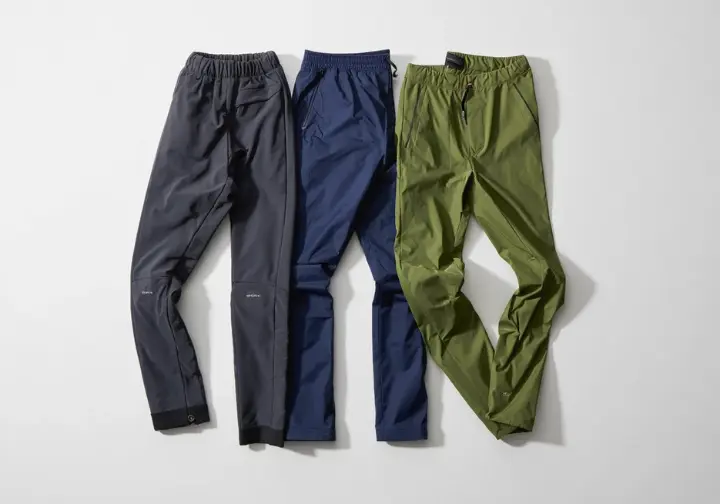
Navigating the sea of options can be tough. Based on expert reviews and climber feedback, here are some highly-regarded women’s rock climbing pants, categorized by their strengths and intended use. Remember, the “best” pant is subjective and depends on your specific needs and preferences.
All-Around Cragging Favs
These pants aim for versatility, balancing durability, stretch, and comfort for everyday climbing, whether at the crag or in the gym.
Patagonia Terravia Alpine Pant | Technical performance for alpine and multi-pitch.
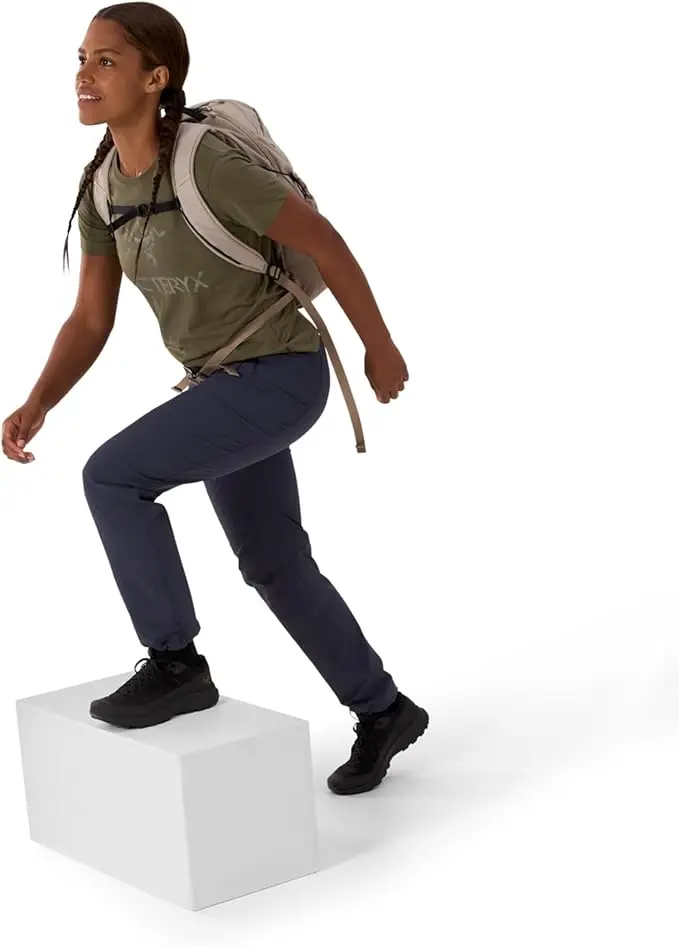
These technical pants are designed for demanding alpine climbing and multi-pitch routes, offering excellent stretch and mobility thanks to their lightweight, breathable 4-way stretch fabric (86% recycled polyester, 14% spandex). The PFAS-free DWR finish and UPF 50+ provide weather resistance and sun protection, essential for long days in the mountains.
The harness-compatible design features a low-profile waistband and adjustable cuffs for a secure fit. Multiple pockets, including zippered thigh pockets, allow for accessible storage. Users praise the exceptional mobility and breathability, making them ideal for three-season use. However, some note the sizing runs small, and the thin nylon fabric may lack durability on highly abrasive rock.
PROS
- Exceptional mobility and 4-way stretch
- Lightweight, breathable, and quick-drying
- Functional harness-compatible design with good pockets
CONS
- Sizing tends to run small/snug
- Thin fabric may lack durability on very abrasive rock
- Higher price point
Outdoor Research Ferrosi Transit Pant | Great value, amazing stretch, and breathability.

A perennial favorite, the Ferrosi fabric (a blend including recycled nylon and spandex) is known for its incredible stretch, breathability, and surprising durability for its weight. These pants are designed as versatile hiking/travel pants but are beloved by many climbers for their comfort and movement-mirroring stretch. The PFAS-free DWR finish and UPF 50+ add protection.
The trim fit with tapered calves and an elastic waistband offers a tailored look that transitions well off the rock. While exceptionally comfortable and mobile, some users find the sizing runs small and the pocket capacity limited. The thin nylon fabric, while abrasion-resistant for its weight, might not withstand the rigors of constant crack climbing like heavier pants. These are excellent comfortable pants for moderate conditions.
PROS
- Exceptional stretch and mobility
- Highly breathable and quick-drying
- Comfortable waistband and versatile style
CONS
- Sizing can run small/snug
- Limited pocket capacity, especially for larger phones
- Thin fabric may wear prematurely with heavy abrasion
Gym & Bouldering Comfort
For indoor climbing or bouldering sessions, comfort, breathability, and freedom of movement are often top priorities.
Black Diamond Notion SP Pant | Very comfortable jogger style, good value, organic cotton.
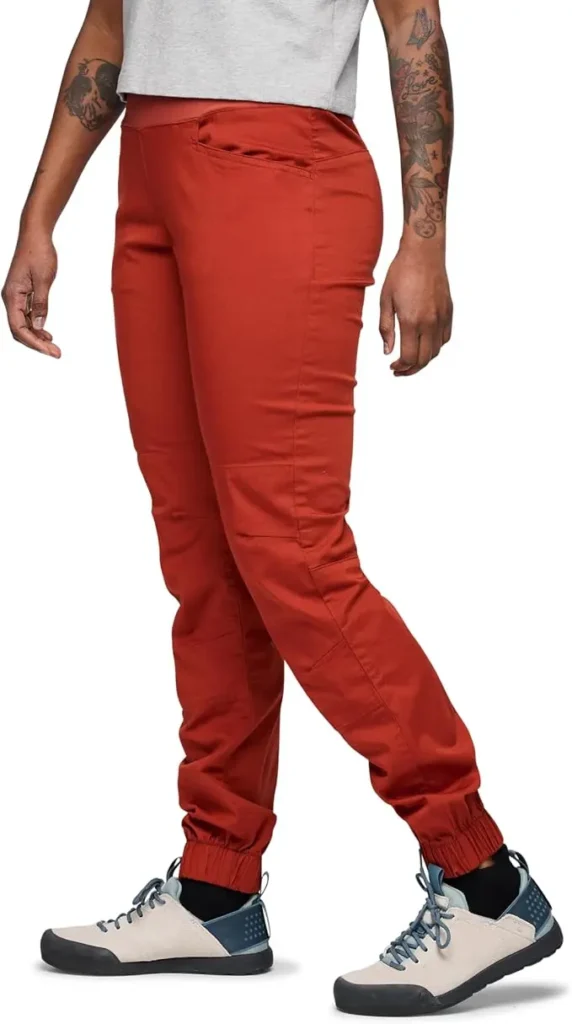
These loose-fitting, high-rise jogger-style pants are incredibly popular for their comfort. Made primarily from organic cotton with a touch of elastane, they feel soft against the skin while still offering enough stretch for dynamic bouldering moves. The elastic waistband with a drawcord is harness-friendly, and the elastic cuffs keep the legs fit snug around the ankles for clear footwork.
Users rave about the “sweatpant-like” comfort, making them ideal for long gym sessions or lounging. The organic cotton fabric is reasonably durable, often lasting through regular use on abrasive gym walls or granite boulders. The main drawbacks noted are that sizing tends to run large, and the cotton isn’t ideal for hot, sweaty conditions or wet weather outdoor climbing. These are fantastic comfortable pants for the climbing gym.
PROS
- Exceptionally comfortable organic cotton fabric
- Good stretch and mobility for bouldering/gym
- Durable for the price point; jogger style is functional
CONS
- Sizing tends to run large
- Cotton fabric is less breathable and slow-drying for hot/wet conditions
- Pocket design could be improved
Mountain Hardwear Dynama High Rise Ankle Pant | Extremely lightweight, breathable, comfortable waistband, versatile fit
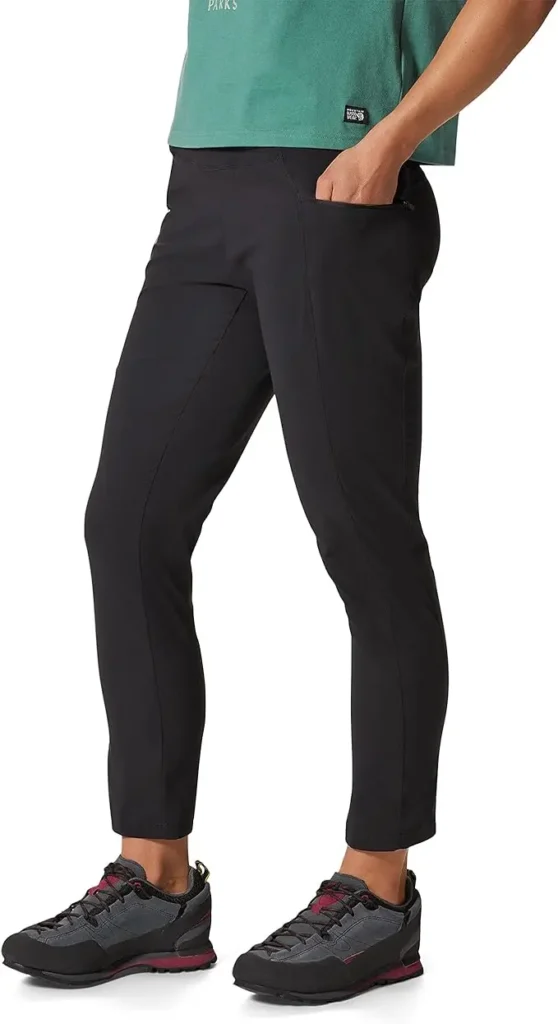
These pants are incredibly lightweight and stretchy, making them feel almost like wearing nothing. The nylon-elastane blend offers excellent 4-way stretch and dries quickly, perfect for warm conditions or intense workouts. The high-rise, low-profile stretch waistband is exceptionally comfortable, even under a pack or harness. A PFAS-free DWR finish and UPF 50+ add protection.
Their versatility is a major plus; they look polished enough for casual wear or even the office, yet perform well for hiking, climbing, or cross-training. The main considerations are the thin nylon fabric, which may not withstand heavy abrasion, and potential sizing inconsistencies, particularly regarding length for shorter individuals. The zippered thigh pocket is useful but might be small for larger phones.
PROS
- Extremely lightweight and highly breathable
- Very comfortable high-rise stretch waistband
- Versatile style transitions well off the trail/wall
CONS
- Thin fabric may lack durability for heavy abrasion
- Sizing/length can be inconsistent
- Pockets are somewhat shallow
Technical & Alpine Performers
For alpine climbing, mountaineering, or rugged traditional climbing, durability, weather resistance, and technical features take center stage.
Mountain Hardwear Chockstone Alpine Pant | Durable softshell built specifically for rugged alpine conditions.
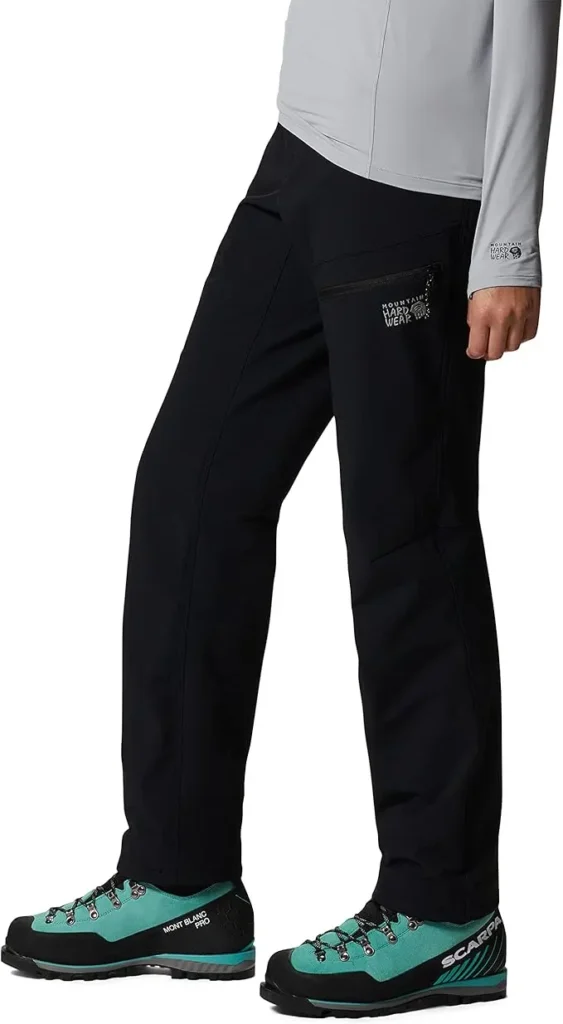
These are burly softshell pants designed for the demands of alpine climbing and guiding. The Chockstone™ double-weave fabric (nylon/elastane) is highly durable and abrasion-resistant, paired with a PFAS-free DWR finish for weather shedding. The stretch ensures mobility for technical moves on rock or ice.
Features are tailored for alpine climbers: harness-compatible zippered pockets, an integrated belt, and ankle hem-cinch cords for a secure fit over boots. The thigh pocket is specifically sized for maps or logbooks. Users praise their toughness for rugged routes. The main trade-offs are the heavier weight and reduced breathability compared to lighter pants, making them best suited for cooler conditions.
PROS
- Exceptional durability and abrasion resistance
- Functional alpine-specific features (pockets, cinch cords)
- Good stretch and mobility despite robust fabric
CONS
- Heavier weight and less breathable than other options
- Sizing can run small/snug
- Higher price point; overkill for casual use
Black Diamond Alpine Light Pant | Lightweight, packable option with good technical features.
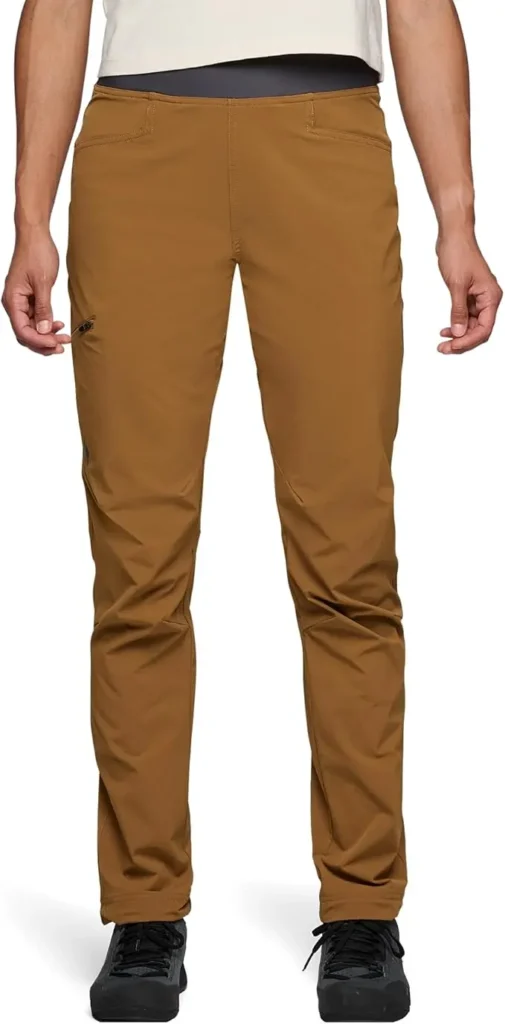
Offering a lighter alternative for three-season mountain pursuits, these pants use a single-weave, four-way stretch nylon/elastic fabric. This makes them highly packable and provides excellent freedom of movement for climbing or fast hiking. A PFAS-free DWR finish offers light weather protection.
Technical features include an adjustable webbing belt, cordlock hems for a customizable fit, and multiple pockets, including a zippered thigh pocket. Users appreciate their low weight and mobility for technical terrain. The primary concern is durability; the lightweight fabric is more susceptible to tearing on sharp rock or dense brush compared to heavier softshell pants. Sizing can also run small.
PROS
- Very lightweight and highly packable
- Excellent mobility and stretch
- Good technical features (adjustable belt/hems, zip pocket)
CONS
- Thin fabric lacks durability for heavy abrasion
- Sizing tends to run small
- Limited weather protection in sustained rain
Budget-Friendly Warriors
You don’t always need to spend a fortune to get functional and comfortable pants for climbing or related activities.
The North Face Aphrodite 2.0 Pant | Highly comfortable, versatile for light activity, affordable.
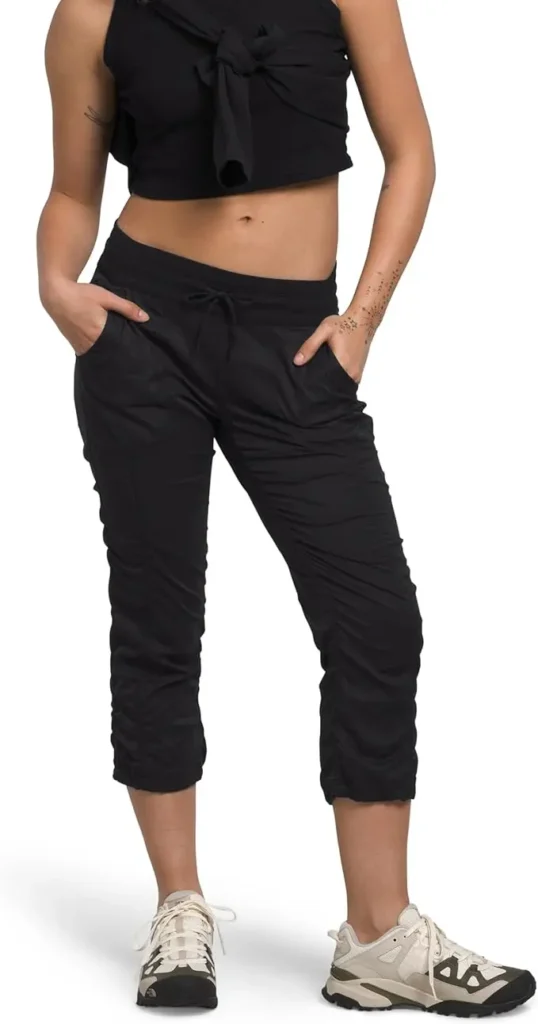
These lightweight, versatile pants are popular for hiking, travel, and casual wear, but their comfort and stretch make them a viable option for light climbing or gym use, especially given their affordable price. The recycled nylon herringbone fabric features four-way stretch and FlashDry™ technology for moisture-wicking, plus a PFAS-free DWR finish.
The wide, rib-knit waistband is very comfortable, and drawcords at the waist and leg openings allow for fit adjustments. Users love the soft feel and flattering fit. However, the fabric is quite thin and may not be durable enough for rugged outdoor climbing, with some reporting pilling or snagging. Sizing can also be inconsistent. A good choice for casual use and light activity.
PROS
- Highly comfortable, soft, stretchy fabric
- Versatile styling for trail-to-town
- Affordable price point
CONS
- Thin material lacks durability for rugged use
- Sizing can be inconsistent
- Limited pocket security
Curvy Fit Champions
Addressing the specific fit needs of climbers with curvier figures is crucial for comfort and performance.
Wondery Isabel 3.0 Outdoor Pant | Adjustable waist specifically designed for curvy figures.
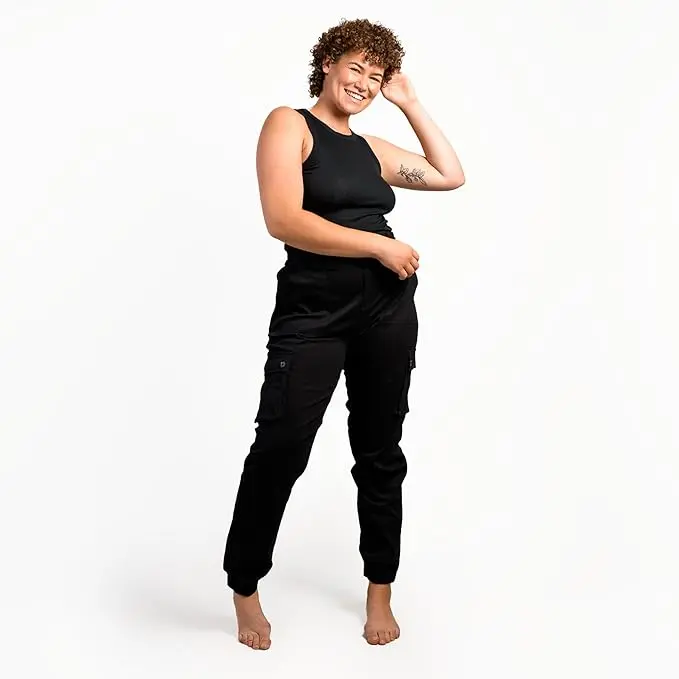
These high-rise jogger-style pants are explicitly designed with curvy figures in mind, aiming to eliminate the common waist gap issue. Made from a recycled cotton-spandex blend, they offer soft comfort and stretch. The adjustable waistband and inclusive sizing range (XXS-6XL) with multiple inseam lengths are major highlights.
Users praise the flattering fit and the six spacious pockets, including zippered options. The soft fabric is comfortable for all-day wear. The main drawbacks are the cotton blend’s tendency to absorb water and dry slowly, making them less ideal for wet conditions, and potential sizing inconsistencies between colors. They offer a great solution for those struggling to find comfortable pants that accommodate wider hips and thighs relative to the waist.
PROS
- Excellent fit specifically designed for curvy figures
- Ample and functional pocket storage
- Soft, comfortable stretch fabric; inclusive sizing
CONS
- Cotton blend absorbs water and dries slowly
- Sizing inconsistencies reported between colors
- Moderate durability; prone to pilling
Choosing Your Climbing Pants
Selecting the ideal women’s rock climbing pants is a personal ascent, balancing technical needs with practical comfort and fit. As we’ve mapped out, certain features significantly enhance performance on the rock.
Consider these key points on your journey:
- Mobility is King: Prioritize stretch (look for spandex/elastane), a gusseted crotch, and articulated knees for unrestricted movement. Can you high-step and stem freely?
- Harness Harmony: Ensure a low-profile waistband and strategically placed pockets (like thigh pockets) that won’t cause discomfort under your climbing harness.
- Material Matters: Choose fabrics based on your needs. Nylon blends offer durability, cotton provides comfort (best for gym/bouldering), polyester dries quickly, and hemp offers a sustainable option. Consider abrasion resistance versus weight and breathability.
- Fit First: This is often the crux for women. Address potential waist gaps or thigh restriction by exploring adjustable waistbands, curvy fits, and different cuts (slim, regular, relaxed). Don’t forget inseam length!
- Discipline Dictates: Your primary climbing style—bouldering, sport climbing, traditional climbing, alpine climbing, or indoor climbing—will influence priorities like durability, weight, and features.
Ultimately, the best climbing pants are the ones you forget you’re wearing – the pair that moves with you, endures the scrapes, works seamlessly with your essential climbing gear, and fits your body perfectly. Research, try options if possible, and consult reviews to find the pair of pants that will support your climbing adventures.
Frequently Asked Questions
Can I just use regular hiking pants for rock climbing? >
What is the single most important feature in climbing pants? >
How tight should women’s climbing pants fit? >
Are cotton climbing pants okay for outdoor climbing? >
We are a participant in the Amazon Services LLC Associates Program, an affiliate advertising program designed to provide a means for sites to earn advertising fees by advertising and linking to Amazon.com. As an Amazon Associate I earn from qualifying purchases. We also participate in other affiliate programs. The information provided on this website is provided for entertainment purposes only. We make no representations or warranties of any kind, expressed or implied, about the completeness, accuracy, adequacy, legality, usefulness, reliability, suitability, or availability of the information, or about anything else. Any reliance you place on the information is therefore strictly at your own risk. Additional terms are found in the terms of service.



